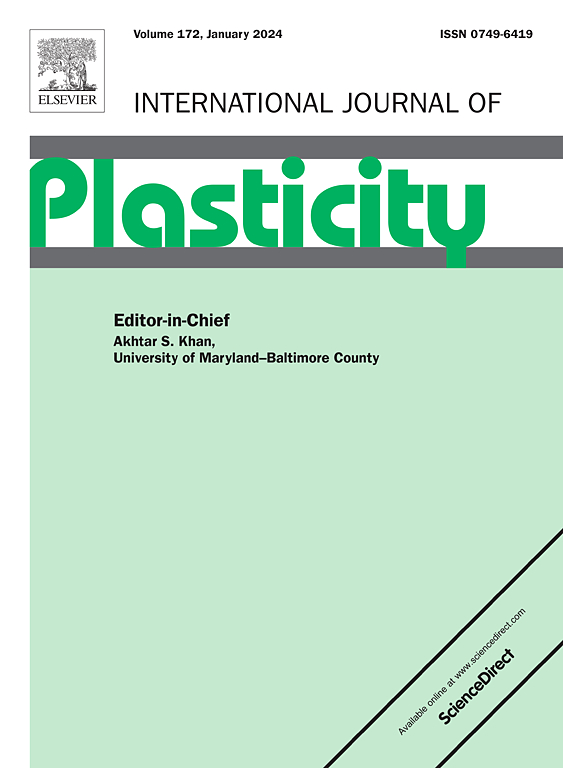揭示梯度纳米晶CoCrFeMnNi高熵合金的抗裂性:分子动力学研究
IF 12.8
1区 材料科学
Q1 ENGINEERING, MECHANICAL
引用次数: 0
摘要
梯度纳米高熵合金(HEAs)为同时提高强度和韧性提供了一条很有前途的途径,但控制其抗断裂性的原子机制尚不清楚。本研究采用分子动力学(MD)模拟方法研究了含中心裂纹和表面裂纹的梯度纳米CoCrFeMnNi HEA (G-HEA)的裂纹扩展行为。与均相合金和纯Ni相比,G-HEA表现出明显的裂纹尖端钝化和韧性裂纹扩展,这是由位错形核和裂纹前沿非晶态层的形成驱动的。值得注意的是,梯度结构通过调节双侧位错活动性来抑制中心裂纹扩展,同时促进表面裂纹扩展。随着变形的进行,应变局部化剪切带逐渐侵蚀梯度结构的增韧效应,导致G-HEA和H-HEA裂纹扩展速率趋同。这些发现证明了梯度纳米结构在调节断裂行为中的重要作用,并为高熵合金的增韧设计提供了原子尺度的见解。本文章由计算机程序翻译,如有差异,请以英文原文为准。


Revealing crack resistance in gradient nano-grained CoCrFeMnNi high-entropy alloys: A molecular dynamics study
Gradient nano-grained high-entropy alloys (HEAs) offer a promising route to concurrently enhance strength and toughness, yet the atomistic mechanisms governing their fracture resistance remain elusive. In this study, molecular dynamics (MD) simulations were employed to unravel the crack propagation behavior of gradient nano-grained CoCrFeMnNi HEA (G-HEA) containing either a central or surface crack. Compared with its homogeneous counterpart and pure Ni, G-HEA exhibits pronounced crack-tip passivation and ductile crack propagation, driven by dislocation nucleation and amorphous layer formation at the crack front. Notably, the gradient structure suppress central crack propagation while promoting surface crack advancement through regulation of bilateral dislocation activity. As deformation proceeds, strain-localized shear bands gradually erode the gradient structure’s toughening benefit, leading to convergence in crack growth rates between G-HEA and H-HEA. These findings demonstrate the significant role of gradient nanostructures in modulating fracture behavior and provide atomic-scale insights for toughening design in high-entropy alloys.
求助全文
通过发布文献求助,成功后即可免费获取论文全文。
去求助
来源期刊

International Journal of Plasticity
工程技术-材料科学:综合
CiteScore
15.30
自引率
26.50%
发文量
256
审稿时长
46 days
期刊介绍:
International Journal of Plasticity aims to present original research encompassing all facets of plastic deformation, damage, and fracture behavior in both isotropic and anisotropic solids. This includes exploring the thermodynamics of plasticity and fracture, continuum theory, and macroscopic as well as microscopic phenomena.
Topics of interest span the plastic behavior of single crystals and polycrystalline metals, ceramics, rocks, soils, composites, nanocrystalline and microelectronics materials, shape memory alloys, ferroelectric ceramics, thin films, and polymers. Additionally, the journal covers plasticity aspects of failure and fracture mechanics. Contributions involving significant experimental, numerical, or theoretical advancements that enhance the understanding of the plastic behavior of solids are particularly valued. Papers addressing the modeling of finite nonlinear elastic deformation, bearing similarities to the modeling of plastic deformation, are also welcomed.
 求助内容:
求助内容: 应助结果提醒方式:
应助结果提醒方式:


